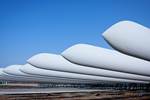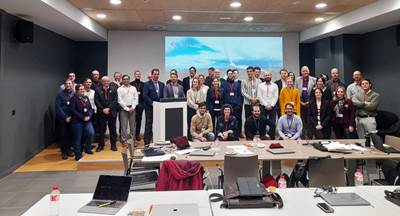RWE Sofia offshore wind farm to use Siemens RecyclableBlades
Large offshore wind farm in the U.K. will have 44 out of 100 of its wind turbines equipped with recyclable composite blades, the largest order to date.
Renewable energy company RWE (Essen, Germany) announces that its U.K. flagship offshore wind project, Sofia, is being made possible with a signed agreement with Siemens Gamesa (Zamudio, Spain). Constructed off the North East coast, Siemens is to deploy its composite RecyclableBlades on 44 of the wind farm’s 100 turbines. This follows the successful installation of recyclable blades at RWE’s Kaskasi wind farm off the German island Heligoland (read “Siemens Gamesa RecyclableBlades installed at RWE offshore wind farm”).
In total, 132 individual recyclable blades will be installed at the 1.4-gigawatt (GW) offshore wind project. RWE says this is the maximum available given the current market capacity for the new specialist resin used in the blades. The new resin type, with a chemical structure, can be efficiently separated from other elements, according to Siemens Gamesa. The process protects the properties of the materials and so enables them to be reused in new casting applications, for example in the automotive industry, or in consumer goods like suitcases and flatscreen casings.
“Sofia is our largest offshore wind farm to date and this is a significant step in taking the long-term sustainability of offshore wind farms to the next level,” Sven Utermöhlen, CEO RWE Offshore Wind, says. “RWE believe this is the right direction for the future of our sector, which has sustainability at its core.”
The development will use the latest SG 14-222 DD turbines with 108-meter-long turbine blades and a 222-meter-rotor diameter.
RWE reports that it has been at the heart of the offshore wind sector since the start, having installed its first offshore turbines at Blyth, U.K., in 2000. Now, as a renewable developer with more than 20 years of experience, it looks to the whole life cycle of its wind farms.
“When we began working with RWE on installing our recyclable blades for their Kaskasi project, we knew that we had taken the first steps on delivering a major change to the renewable wind sector,” Clark MacFarlane, U.K. managing director, Siemens Gamesa, notes. “Having the opportunity to produce even more for Sofia is fantastic and fully demonstrates our and RWE’s focus on developing and delivering greater levels of sustainability for renewable generation globally.”
As part of the agreement, 50% of Sofia’s turbine blades will be produced in the U.K. at Siemens Gamesa’s Hull factory. This supports local supply chain ambitions and reinforces the growing role the Humber region has to play in supplying the growing offshore wind industry.
Other technologies are being developed to recycle conventional turbine blades that reach the end of their lifecycle. However, RWE says, these new blades, made recyclable from the outset, represent a key next step in terms of maximizing sustainability and environmental benefits.
RWE has a strong U.K. pipeline with involvement in four of the U.K.’s seven offshore wind extension projects, and the Round 4 project Dogger Bank South. Meanwhile, the company is also exploring floating wind projects including in the Celtic Sea region.
The Sofia offshore wind farm is located on Dogger Bank in the central North Sea, 195 kilometers off the North East coast of the U.K. Offshore installation is expected to begin in 2023, with project completion in 2026. The development will use the latest SG 14-222 DD turbines with 108-meter-long turbine blades and a 222-meter-rotor diameter.
Related Content
Bio-based acrylonitrile for carbon fiber manufacture
The quest for a sustainable source of acrylonitrile for carbon fiber manufacture has made the leap from the lab to the market.
Read MoreNatural fiber composites: Growing to fit sustainability needs
Led by global and industry-wide sustainability goals, commercial interest in flax and hemp fiber-reinforced composites grows into higher-performance, higher-volume applications.
Read MoreThe lessons behind OceanGate
Carbon fiber composites faced much criticism in the wake of the OceanGate submersible accident. CW’s publisher Jeff Sloan explains that it’s not that simple.
Read MoreTU Munich develops cuboidal conformable tanks using carbon fiber composites for increased hydrogen storage
Flat tank enabling standard platform for BEV and FCEV uses thermoplastic and thermoset composites, overwrapped skeleton design in pursuit of 25% more H2 storage.
Read MoreRead Next
European project EoLO-HUBs targets wind turbine blade recycling
The 18-member consortium will develop and use green chemistry processes to recycle composite materials and, among others, optimize the dismantling of wind farms through advanced software.
Read MorePilot program turns EOL wind blades to liners for pipe infrastructure
TPI Composites, Tex-Tech and Carbon Rivers partner to process wind blades, pyrolyze the material and use the recovered glass fibers to give new life to damaged existing pipelines.
Read MoreSiemens Gamesa brings RecyclableBlade to onshore wind power projects
Recyclable wind blade is already installed and in full operation at offshore projects, leading Siemens Gamesa toward its goal to produce fully recyclable wind turbines by 2040.
Read More














.jpg;maxWidth=300;quality=90)









